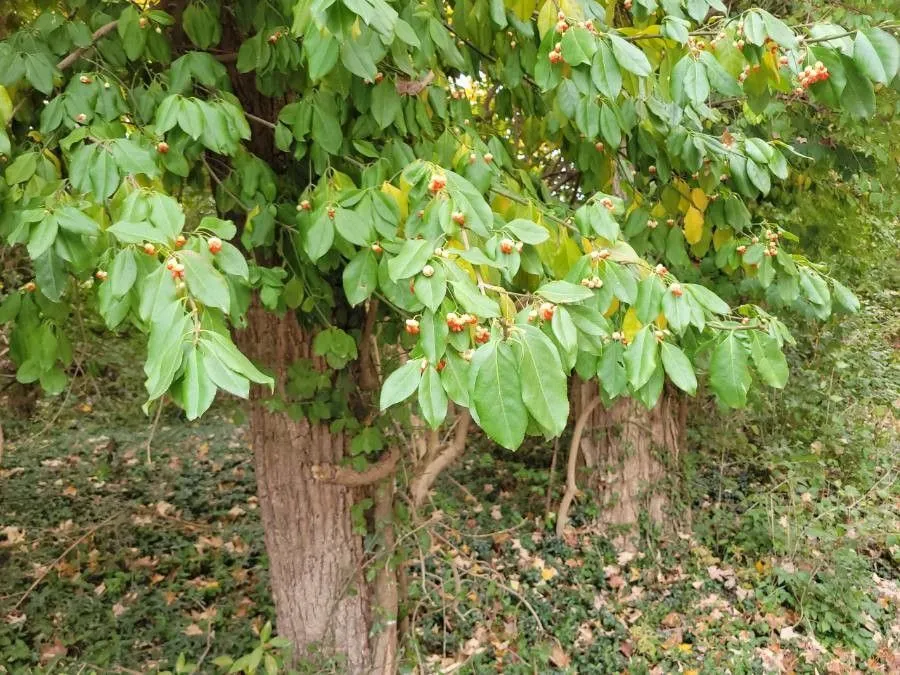
Author: L.
Bibliography: Sp. Pl.: 196 (1753)
Year: 1753
Status: accepted
Rank: species
Genus: Celastrus
Vegetable: False
Observations: C. & E. Canada to N. & E. & C. U.S.A.
The American bittersweet, scientifically known as Celastrus scandens, is a beautiful and vigorous deciduous climbing vine native to North America. Renowned for its eye-catching autumnal display, this plant is a popular choice for adding a splash of color to gardens and natural landscapes from Central and Eastern Canada through most of the United States, particularly in the north, east, and central regions.
A quintessential member of the Celastraceae family, the American bittersweet has captured the attention of botanists since its initial description by the esteemed Swedish botanist Carl Linnaeus in the seminal work “Species Plantarum,” published in 1753. This versatile climber thrives in a variety of environments, typically favoring well-drained soils and sunny to partially shaded locations. It can often be found gracing woodland edges, fences, and trellises with its twining, spiraling growth habit.
The foliage of the American bittersweet consists of oval to lance-shaped leaves that exhibit a rich green hue during the growing season before transitioning to vibrant yellow in the fall. However, it is the plant’s distinctive fruit that truly sets it apart. In late summer to early autumn, the vine produces small clusters of greenish-white flowers followed by striking orange capsules. As these capsules mature, they split open to reveal vivid red seeds, offering a dramatic visual contrast that persists well into winter, providing both aesthetic appeal and nourishment for wildlife.
Despite its beauty, it is essential for gardeners and conservationists to ensure that American bittersweet is not confused with its invasive relative, Oriental bittersweet (Celastrus orbiculatus), which can outcompete native flora and disrupt ecosystems. Identification can be aided by examining the fruit, as the American species typically has fewer, more sizable capsules located at the ends of branches, whereas the Oriental variety has numerous smaller clusters situated along the stems.
In conclusion, the American bittersweet is a robust and enchanting plant that brings dynamic seasonal interest to the landscape. Its historic botanical recognition and wide ecological range underscore its significance and adaptability, making it a cherished species for both ornamental use and natural habitat restoration.
Eng: american bittersweet, staffvine, waxwork, climbing bittersweet, shrubby bittersweet
Deu: kletternder baumwürger
Swe: amerikansk träddödare
Hun: kúszó fafojtó
Fra: bourreau-des-arbres, célastre grimpant
Nno: slyngfrøbusk
Nob: slyngfrøbusk
En: American bittersweet, Staffvine, Waxwork, Climbing bittersweet, Shrubby bittersweet, Climbing Staff-tree, False Bittersweet, Staff-vine
Be: Дрэвагубец
Zh: 爬藤卫矛
Cs: Jesenec popínavý
Da: Amerikansk Celaster
Nl: Boomwurger
Fi: Amerikankelasköynnös
Fr: Bourreau-des-arbres, Célastre grimpant, Bourreau des arbres
De: Amerikanischer Baumwürger, Kletternder Baumwürger
Hu: Kúszó fafojtó
Nb: Slyngfrøbusk
Nn: Slyngfrøbusk
Sv: Amerikansk träddödare
Taken Nov 25, 2018 by Emmanuelle Richard (cc-by-sa)
Taken Nov 7, 2021 by nicole sikler (cc-by-sa)
Taken Oct 9, 2021 by Clara Kent (cc-by-sa)
Taken Nov 4, 2018 by Abe Fitch (cc-by-sa)
Taken Dec 12, 2018 by José Carlos López (cc-by-sa)
Taken Oct 14, 2021 by Sgrges Grges (cc-by-sa)
Taken Sep 18, 2021 by Richard Wideman (cc-by-sa)
Taken Jul 25, 2022 by William Wattles (cc-by-sa)
Taken Jun 7, 2020 by Chuck Nugent (cc-by-sa)
Taken Jul 9, 2021 by Renee Desmarais (cc-by-sa)
Taken Oct 12, 2022 by Reno Reno (cc-by-sa)
Taken Dec 24, 2021 by Charles Stenken (cc-by-sa)
Taken Nov 9, 2012 by EOL − Johnny Wilson (cc-by-nc)
Taken Feb 14, 2021 by gwtaylor (cc-by-sa)
Taken Jan 30, 2022 by Jorge Vinicius Calixto (cc-by-sa)
Taken Sep 23, 2022 by Myles Collins (cc-by-sa)
Taken Jun 5, 2022 by Sophie Marie Schnurre (cc-by-sa)
Taken Jun 6, 2020 by Diana Vedula (cc-by-sa)
Taken Jul 20, 2022 by Morrissey (cc-by-sa)
Taken Sep 22, 2022 by Meskerem David Melessa (cc-by-sa)
Taken Jan 1, 1900 by EOL − National Geographic Society (cc-by-nc-sa)
Taken Oct 11, 2015 by EOL − Patrick Leary (cc-by-nc-sa)
Taken Jun 6, 2022 by Łanocha Karol (cc-by-sa)
Taken Jun 6, 2022 by Łanocha Karol (cc-by-sa)
Taken Nov 9, 2021 by Sonlight (cc-by-sa)
Taken Sep 2, 2021 by Jessica rossi (cc-by-sa)
Growth form>: Thicket Forming
Growth habit>: Vine
Growth rate>: Rapid
Ph maximum: 7.5
Ph minimum: 5.0
Family: Myrtaceae Author: (F.Muell.) K.D.Hill & L.A.S.Johnson Bibliography: Telopea 6: 402 (1995) Year: 1995 Status:…
Family: Rubiaceae Author: Pierre ex A.Froehner Bibliography: Notizbl. Bot. Gart. Berlin-Dahlem 1: 237 (1897) Year:…
Family: Sapindaceae Author: Koidz. Bibliography: J. Coll. Sci. Imp. Univ. Tokyo 32(1): 38 (1911) Year:…
Family: Asteraceae Author: A.Gray Bibliography: Pacif. Railr. Rep.: 107 (1857) Year: 1857 Status: accepted Rank:…
Family: Fabaceae Author: Medik. Bibliography: Vorles. Churpfälz. Phys.-Ökon. Ges. 2: 398 (1787) Year: 1787 Status:…
Family: Aspleniaceae Author: (Cav.) Alston Bibliography: Bull. Misc. Inform. Kew 1932: 309 (1932) Year: 1932…